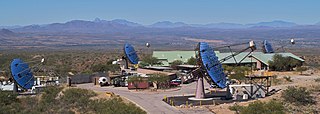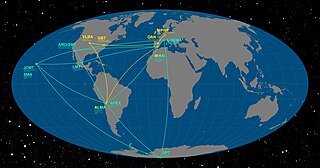
A quasar is an extremely luminous active galactic nucleus (AGN). It is pronounced KWAY-zar, and sometimes known as a quasi-stellar object, abbreviated QSO. This emission from a galaxy nucleus is powered by a supermassive black hole with a mass ranging from millions to tens of billions of solar masses, surrounded by a gaseous accretion disc. Gas in the disc falling towards the black hole heats up because of friction and releases energy in the form of electromagnetic radiation. The radiant energy of quasars is enormous; the most powerful quasars have luminosities thousands of times greater than that of a galaxy such as the Milky Way. Usually, quasars are categorized as a subclass of the more general category of AGN. The redshifts of quasars are of cosmological origin.
High energy astronomy is the study of astronomical objects that release electromagnetic radiation of highly energetic wavelengths. It includes X-ray astronomy, gamma-ray astronomy, extreme UV astronomy, neutrino astronomy, and studies of cosmic rays. The physical study of these phenomena is referred to as high-energy astrophysics.

The European Organisation for Astronomical Research in the Southern Hemisphere, commonly referred to as the European Southern Observatory (ESO), is an intergovernmental research organisation made up of 16 member states for ground-based astronomy. Created in 1962, ESO has provided astronomers with state-of-the-art research facilities and access to the southern sky. The organisation employs over 750 staff members and receives annual member state contributions of approximately €162 million. Its observatories are located in northern Chile.

A supermassive black hole is the largest type of black hole, with its mass being on the order of hundreds of thousands, or millions to billions of times the mass of the Sun (M☉). Black holes are a class of astronomical objects that have undergone gravitational collapse, leaving behind spheroidal regions of space from which nothing can escape, not even light. Observational evidence indicates that almost every large galaxy has a supermassive black hole at its center. For example, the Milky Way has a supermassive black hole in its Galactic Center, corresponding to the radio source Sagittarius A*. Accretion of interstellar gas onto supermassive black holes is the process responsible for powering active galactic nuclei (AGNs) and quasars.

A blazar is an active galactic nucleus (AGN) with a relativistic jet directed very nearly towards an observer. Relativistic beaming of electromagnetic radiation from the jet makes blazars appear much brighter than they would be if the jet were pointed in a direction away from Earth. Blazars are powerful sources of emission across the electromagnetic spectrum and are observed to be sources of high-energy gamma ray photons. Blazars are highly variable sources, often undergoing rapid and dramatic fluctuations in brightness on short timescales. Some blazar jets exhibit apparent superluminal motion, another consequence of material in the jet traveling toward the observer at nearly the speed of light.

A BL Lacertae object or BL Lac object is a type of active galactic nucleus (AGN) or a galaxy with such an AGN, named after its prototype, BL Lacertae. In contrast to other types of active galactic nuclei, BL Lacs are characterized by rapid and large-amplitude flux variability and significant optical polarization. Because of these properties, the prototype of the class was originally thought to be a variable star. When compared to the more luminous active nuclei (quasars) with strong emission lines, BL Lac objects have spectra dominated by a relatively featureless non-thermal emission continuum over the entire electromagnetic range. This lack of spectral lines historically hindered identification of the nature and distance of such objects.

Neutrino astronomy is the branch of astronomy that observes astronomical objects with neutrino detectors in special observatories. Neutrinos are created as a result of certain types of radioactive decay, nuclear reactions such as those that take place in the Sun or high energy astrophysical phenomena, in nuclear reactors, or when cosmic rays hit atoms in the atmosphere. Neutrinos rarely interact with matter, meaning that it is unlikely for them to scatter along their trajectory, unlike photons. Therefore, neutrinos offer a unique opportunity to observe processes that are inaccessible to optical telescopes, such as reactions in the Sun's core. Neutrinos can also offer a very strong pointing direction compared to charged particle cosmic rays.

Messier 77 or M77, also known as NGC 1068 and the Squid Galaxy, is a barred spiral galaxy about 47 million light-years away in the constellation Cetus. Messier 77 was discovered by Pierre Méchain in 1780, who originally described it as a nebula. Méchain then communicated his discovery to Charles Messier, who subsequently listed the object in his catalog. Both Messier and William Herschel described this galaxy as a star cluster. Today, however, the object is known to be a galaxy.

An optically violent variable quasar is a type of highly variable quasar. It is a subtype of blazar that consists of a few rare, bright radio galaxies, whose visible light output can change by 50% in a day. OVV quasars have essentially become unified with highly polarized quasars (HPQ), core-dominated quasars (CDQ), and flat-spectrum radio quasars (FSRQ). Different terms are used but the term FSRQ is gaining popularity effectively making the other terms archaic.

The IceCube Neutrino Observatory is a neutrino observatory constructed at the Amundsen–Scott South Pole Station in Antarctica. The project is a recognized CERN experiment (RE10). Its thousands of sensors are located under the Antarctic ice, distributed over a cubic kilometre.

The Max-Planck-Institut für Astronomie is a research institute of the Max Planck Society (MPG). It is located in Heidelberg, Baden-Württemberg, Germany near the top of the Königstuhl, adjacent to the historic Landessternwarte Heidelberg-Königstuhl astronomical observatory. The institute primarily conducts basic research in the natural sciences in the field of astronomy.

A neutrino detector is a physics apparatus which is designed to study neutrinos. Because neutrinos only weakly interact with other particles of matter, neutrino detectors must be very large to detect a significant number of neutrinos. Neutrino detectors are often built underground, to isolate the detector from cosmic rays and other background radiation. The field of neutrino astronomy is still very much in its infancy – the only confirmed extraterrestrial sources as of 2018 are the Sun and the supernova 1987A in the nearby Large Magellanic Cloud. Another likely source is the blazar TXS 0506+056 about 3.7 billion light years away. Neutrino observatories will "give astronomers fresh eyes with which to study the universe".

VERITAS is a major ground-based gamma-ray observatory with an array of four 12 meter optical reflectors for gamma-ray astronomy in the GeV – TeV photon energy range. VERITAS uses the Imaging Atmospheric Cherenkov Telescope technique to observe gamma rays that cause particle showers in Earth's atmosphere that are known as extensive air showers. The VERITAS array is located at the Fred Lawrence Whipple Observatory, in southern Arizona, United States. The VERITAS reflector design is similar to the earlier Whipple 10-meter gamma-ray telescope, located at the same site, but is larger in size and has a longer focal length for better control of optical aberrations. VERITAS consists of an array of imaging telescopes deployed to view atmospheric Cherenkov showers from multiple locations to give the highest sensitivity in the 100 GeV – 10 TeV band. This very high energy observatory, completed in 2007, effectively complements the Large Area Telescope (LAT) of the Fermi Gamma-ray Space Telescope due to its larger collection area as well as coverage in a higher energy band.
Kenneth Irwin Kellermann is an American astronomer at the National Radio Astronomy Observatory. He is best known for his work on quasars. He won the Helen B. Warner Prize for Astronomy of the American Astronomical Society in 1971, and the Bruce Medal of the Astronomical Society of the Pacific in 2014.

Extragalactic cosmic rays are very-high-energy particles that flow into the Solar System from beyond the Milky Way galaxy. While at low energies, the majority of cosmic rays originate within the Galaxy (such as from supernova remnants), at high energies the cosmic ray spectrum is dominated by these extragalactic cosmic rays. The exact energy at which the transition from galactic to extragalactic cosmic rays occurs is not clear, but it is in the range 1017 to 1018 eV.

The Event Horizon Telescope (EHT) is a large telescope array consisting of a global network of radio telescopes. The EHT project combines data from several very-long-baseline interferometry (VLBI) stations around Earth, which form a combined array with an angular resolution sufficient to observe objects the size of a supermassive black hole's event horizon. The project's observational targets include the two black holes with the largest angular diameter as observed from Earth: the black hole at the center of the supergiant elliptical galaxy Messier 87, and Sagittarius A* at the center of the Milky Way.
Multi-messenger astronomy is astronomy based on the coordinated observation and interpretation of disparate "messenger" signals. Interplanetary probes can visit objects within the Solar System, but beyond that, information must rely on "extrasolar messengers". The four extrasolar messengers are electromagnetic radiation, gravitational waves, neutrinos, and cosmic rays. They are created by different astrophysical processes, and thus reveal different information about their sources.
TXS 0506+056 is a very high energy blazar – a quasar with a relativistic jet pointing directly towards Earth – of BL Lac-type. With a redshift of 0.3365 ± 0.0010, it is about 1.75 gigaparsecs from Earth. Its approximate location on the sky is off the left shoulder of the constellation Orion. Discovered as a radio source in 1983, the blazar has since been observed across the entire electromagnetic spectrum.

Frank Eisenhauer is a German astronomer and astrophysicist. He is best known for his contributions to interferometry and spectroscopy and the study of the black hole at the centre of the Milky Way.
Laura Maraschi is an Italian astronomer. She works for the Brera Astronomical Observatory. In 2013, she was on the organizing committee of the International Astronomical Union Symposium 304.















